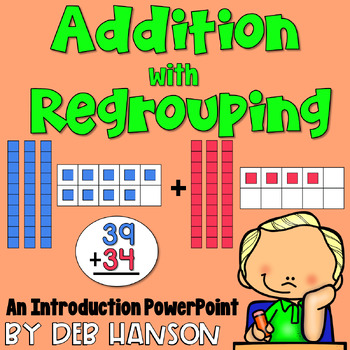Addition with Regrouping PowerPoint Lesson
- Zip
What educators are saying
Description
Introduce or review addition with regrouping with this 47-slide PowerPoint! It is designed to teach your students how to solve 2-digit and 3-digit addition problems. A companion handout is included so that you have the option of having your students work through each problem as you progress through the PowerPoint.
HERE'S THE SEQUENCE OF TOPICS COVERED IN THIS POWERPOINT:
Slides 1-18: Adding 2-digit numbers with regrouping using base-ten blocks. This section features four different problems. It is fully animated so that when regrouping is necessary, the ten ones drop OFF the screen and is immediately replaced with a ten rod. This allows your students to watch what happens on the screen, and then do the same action with the base-ten blocks on their desk. Also, one of the problems in the middle of this section does NOT require regrouping, teaching students that you must check to make sure regrouping is necessary before regrouping.
Slides 19-25: Adding 2-digit numbers on paper without base-ten blocks. The teacher on the PowerPoint gives the students the tip of turning lined paper sideways so that they have columns to work with. Then, five practice problems are presented and completed.
Slides 26-37: Adding 3-digit numbers with regrouping using base-ten blocks. This section features 3 different problems. This section is arranged just like the first set of slides (mentioned above) where base-ten blocks are used as models.
Slides 38-47: Adding 3-digit numbers on paper without base-ten blocks. 5 practice problems are presented and completed.
PowerPoints filled with visuals are ideal for teaching new content to students because PowerPoints tend to be highly engaging and concepts can be easily broken down into understandable chunks of information. But let's face it... they are so time-consuming to create! Fortunately, now you have an option of using one that is already complete, kid-tested, and ready to go for you!
Here's what teachers like you have to say about this addition with regrouping PowerPoint:
⭐️ Hollie A. said, "This was a great resource to use with my struggling learners during intervention time. It takes it step-by-step with visual models. I would definitely recommend this product!"
⭐️ Tasha L. said, "This was perfect! I loved that it started with 2 digits and worked its way up. I like that base ten blocks were used to show the why. It really helped my students understand!"
⭐️ Jeri H. said, "I was able to use this to help students understand the theory behind regrouping. This was a great visual way to help students understand how and why we regroup when adding. It also tied the theory to the algorithm."
⭐️ Norma A. said, "Great resource to use when introducing addition. I used it to help struggling students in small group."
Check out the preview!! Various problems from each of the four sections described above is included in this preview. WHEN VIEWING THE PREVIEW, PLEASE MAKE SURE YOU ARE VIEWING IT IN SLIDE SHOW MODE. (The slides will not work properly unless you start the slide show.)
Directions for starting the PowerPoint or preview in slide show mode:
- Open the PowerPoint file.
- Near the top of your computer screen, there is a menu bar. Click on the words "SLIDE SHOW".
- A new dropdown box should appear, and the button at the far left should say "FROM BEGINNING". Click on that button.
- Now the PowerPoint should fill your entire computer screen. From this point on, click on the mouse over and over to advance the PowerPoint. The base-ten blocks will now be able to move on and off the screen at the proper time.
Please note: You DO have my permission to convert this PowerPoint to Google Slides, and to share it with your students via Google Classroom. (A Google link is not provided, but you may upload the PowerPoint to Google yourself, if you wish.)
Feel free to check out my related PowerPoint: Subtraction with Regrouping.
Copyright by Deb Hanson
Please note: The PowerPoint cannot be edited due to the copyright requirements made by the contributing artists (clip art, font, background).
This item is a paid digital download from my TpT store
www.teacherspayteachers.com/Store/Deb-Hanson
This product is to be used by the original downloader only. Copying for more than one teacher is prohibited. This item is also bound by copyright laws. Redistributing, editing, selling, or posting this item (or any part thereof) on an Internet site that is not password protected are all strictly prohibited without first gaining permission from the author. Violations are subject to the penalties of the Digital Millennium Copyright Act. Please contact me if you wish to be granted special permissions!





